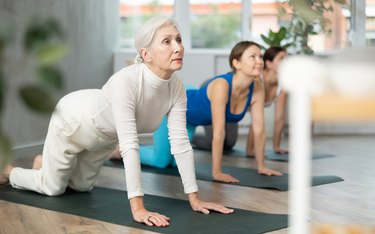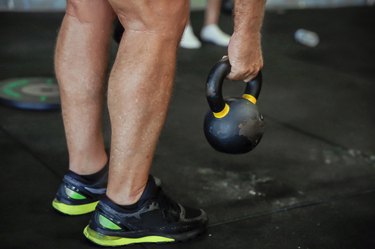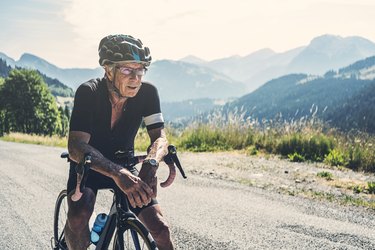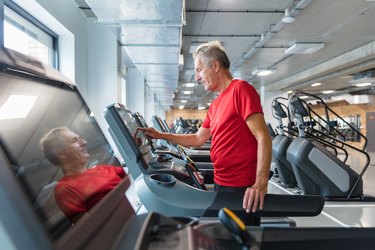
Experts agree that if you want a strong, healthy body in your golden years, staying active is key, and strength training and stretching are essential for long-term health. But another crucial component to longevity is often overlooked: proprioception.
"Healthy aging is heavily dependent on the amount of movement you consistently perform," says Grayson Wickham, DPT, CSCS, founder of the Movement Vault. "And proprioception is essentially the technical word for body awareness." In simple terms, it's knowing where your body is in space.
Video of the Day
When your proprioceptive skills are on point, you likely don't give them much thought. But your joints are in constant communication with your brain and nervous system to maintain body awareness.
Your joints have receptors that send information to your brain and spinal cord, Wickham says. This information is then processed, helping your nervous system to determine the current status of your joints. This is how you sense your body's position and spatial orientation.
How Proprioception Is Linked to Longevity
"The better your proprioception is, the less likely you are to get injured and/or damage your joints," Wickham says. Both problems can sideline you in your senior years.
Not only can injuries and joint pain diminish your quality of life, but they can also prevent you from performing day-to-day activities like cleaning the house, climbing the stairs and doing laundry, Wickham says.
Making matters worse, an injury or joint pain can also prevent you from exercising, which, as we know, is critical for long-term physical health.
Having great joint proprioception will also help enhance your physical performance, athleticism and muscle activation, Wickham says. That's because when you have a good sense of where your body and joints are, your movements become more efficient and coordinated.
Better coordination also translates to better balance, which can decrease your risk for falls, Wickham says. This is especially important because falls can become a big problem for many people as they age, he says.
Case in point: One in four senior Americans will take a tumble every year, and one-fifth of these falls will result in a serious injury, such as broken bones or a head trauma, per the Centers for Disease Control and Prevention (CDC).
So developing proprioception — which helps you stay injury-free and preserve healthy joints — is vital for maintaining independence as an older adult.
9 Exercises for Better Proprioception
In combination with resistance training and active stretching, these proprioception exercises can help you reduce injury risk and improve joint health as you age.
1. Hip Full-Range Activation
- Start on your hands and knees with your hands under your shoulders and knees under your hips.
- Lift your left leg out to your side, around to the back, then back to the starting position. Imagine you’re making a circle with your knee.
- Then reverse the movement, lifting your left leg to the back, around to the side and back to the front.
- Focus on moving your hip through its full range of motion, making as big a circle as possible in both directions.
- One repetition equals a hip circle in both directions. Perform 10 repetitions, then switch to your right leg and repeat.
2. Ankle Full-Range Activation
- Sit on the floor cross-legged. Place your hands around your left knee and lift it so it's perpendicular to the floor. Gently hold your knee, helping to keep your lower leg still.
- Lift your left toes and start rotating your foot, making small circles with your ankle in one direction, then reverse in the opposite direction. Your goal is to move your ankle through its maximum range of motion.
- One repetition equals an ankle circle in both directions. Do 10 repetitions per ankle.
3. Segmented Cat-Cows
- Get into tabletop position, on your hands and knees with a flat back.
- While keeping the rest of your spine and body still, slowly start to arch your hips and lower back. Move one vertebra at a time until your entire spine and neck are fully arched and extended.
- Hold this position, then bring your chin to your chest, flexing your neck. Continue to flex your upper back, middle back and lower back until your entire spine is fully arched again.
- This equals 1 repetition. Perform 10 repetitions.
4. Knee Full-Range Activation
- Sit on the floor cross-legged. Lift your right leg, and wrap your right arm underneath your right leg so your right forearm is against your right hamstring. Pull your knee in toward your chest.
- Rotate your knee as far as possible to the right while maximally straightening your knee.
- Next, rotate your knee to the left side and then bend your knee as much as possible. Your foot will be moving but you want the movement to be initiated at the knee.
- Perform the above steps in the reverse direction. That’s 1 repetition. Perform 10 repetitions per knee.
5. Shoulder Windmills Full-Range Activation
- Start in a half kneeling position, with your left leg in a 90-degree position and your right shin on the ground. Hold your arms straight by your side. Make a lose fist with your left hand with your thumb facing forward.
- Flex your left shoulder up and bring your left arm overhead. Once you reach the top, rotate your shoulder forward, so your thumb is now pointed forward.
- Continue making an arm circle backward as far as you can while continually rotating your left shoulder inward (your thumb should now be pointed backwards) until your arm returns to your side.
- Then reverse the motion. This is 1 repetition. Perform 5 repetitions per side.
6. Shoulder Blade Full-Range Activation
- Start in a half kneeling position, with your right knee and shin on the floor and your left knee at a 90-degree angle.
- Stretch both arms directly in front of you and keep them as straight as possible the entire time. Make loose fists with your hands.
- Shrug your shoulder blades up as far as you can and pinch your shoulder blades together. Keep your shoulder blades pinched and then depress them downwards
- Next, spread them apart.
- Reverse the movement, performing the same steps in the opposite direction. That’s 1 repetition. Perform 10 repetitions.
Tip
Imagine making rounded squares with your shoulder blades, Wickham says.
7. Neck Full-Range Activation
- Get into a comfortable seated position, preferably kneeling.
- Bring your chin to your chest. Rotate your neck, bringing your left ear to your left shoulder.
- Continue your circle, extending your neck backward as far as possible, until you bring your right ear to your right shoulder.
- Rotate back to the starting position with your chin to your chest, then circle in the opposite direction. That’s 1 repetition.
- Your goal is to move your neck through your maximal, pain-free range of motion.
- Perform 5 repetitions.
8. Hip Abduction to Flexion
- Start by lying on your stomach with your elbows and forearms on the ground.
- Keeping the front of your hips as close to the ground as possible, extend your left hip up as high as you can, lifting your left leg behind you.
- Next, slowly bend your left knee and move your left leg to your side and upward toward your waist. The goal is to touch your left elbow with your knee before reversing the movement and returning to a straight-legged starting position.
- Perform 7 repetitions per side.
9. Around-the-World
- Start in a half kneeling position with one foot planted in front and your back knee on the ground.
- Lift your arms overhead in a V-shape and keep them as straight as possible the entire time, making loose fists with your hands.
- Bend your entire body to one side. Reach and rotate diagonally to the corner in front of you.
- Continue to slowly rotate, moving your torso and arms forward into the center, the opposite corner and finally to the side before coming back to an upright position.
- Repeat the movement in the reverse direction. That’s 1 repetition. Perform 5 repetitions.
More Ways to Age Well
Was this article helpful?
150 Characters Max
0/150
Thank you for sharing!
Thank you for your feedback!



